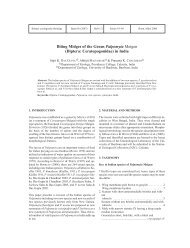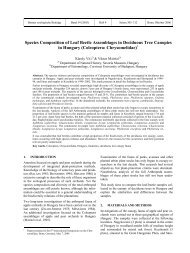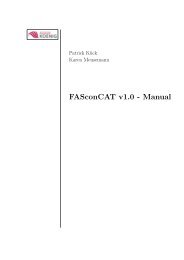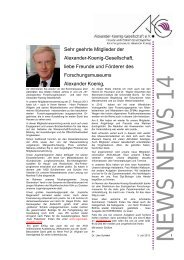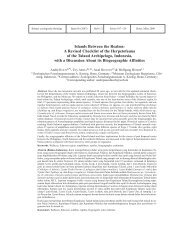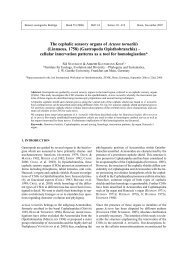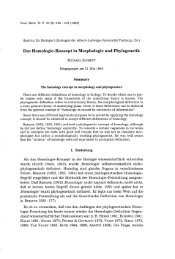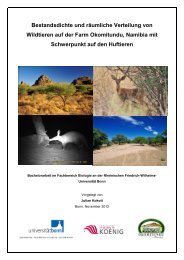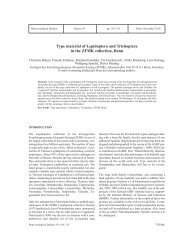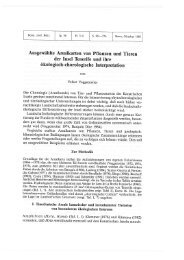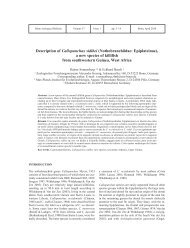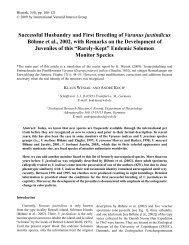Biogeography of the Sacoglossa (Mollusca, Opisthobranchia)*
Biogeography of the Sacoglossa (Mollusca, Opisthobranchia)*
Biogeography of the Sacoglossa (Mollusca, Opisthobranchia)*
Create successful ePaper yourself
Turn your PDF publications into a flip-book with our unique Google optimized e-Paper software.
Bonner zoologische Beiträge 55 (2006)<br />
263<br />
Table 6. Similarity <strong>of</strong> provinces <strong>of</strong> <strong>the</strong> Australian continent. Due to <strong>the</strong> high similarity between <strong>the</strong> Nor<strong>the</strong>ast Australian province<br />
and <strong>the</strong> Great Barrier Reef, <strong>the</strong>se two provinces have been merged (NE Aus+GBR). Abbreviations as in Tab. 3.<br />
a.<br />
CJ \ SD NE Austr GBR NE Aus+ GBR N+NW Austr SW+S Austr SE Austr<br />
N=18 N=22 N=28 N=23 N=22 N=15<br />
NE Australia - 60.0 - 34.1 30.0 30.3<br />
GBR 42.9 - - 26.7 18.2 16.2<br />
NE Aus+GBR - - - 31.4 28.0 27.9<br />
N+NW Austr 20.6 15.4 19.0 - 48.8 26.3<br />
SW+S Austr 17.6 10.0 16.3 32.4 - 43.2<br />
SE Austr 17.9 8.82 16.2 15.2 27.6 -<br />
b.<br />
I NE Austr GBR NE Aus+GBR N+NW Austr SW+S Austr<br />
NE Australia - - - - -<br />
GBR 66.7 - - - -<br />
NE Aus+GBR - - - - -<br />
N+NW Austr 38.9 27.3 34.8 - -<br />
SW+S Austr 33.3 18.2 31.8 50.0 -<br />
SE Austr 33.3 20.0 40.0 33.3 53.3<br />
<strong>the</strong> highest affinity to <strong>the</strong> fauna <strong>of</strong> North and Northwestern<br />
Australia, and <strong>the</strong> o<strong>the</strong>r way around, whereas <strong>the</strong> fauna<br />
<strong>of</strong> Sou<strong>the</strong>astern Australia (BURN 1958, 1960, 1965,<br />
1974, 1998, 2006) has a higher affinity to <strong>the</strong> fauna <strong>of</strong><br />
South and Southwestern Australia than to that <strong>of</strong> Nor<strong>the</strong>astern<br />
Australia and <strong>the</strong> Great Barrier Reef (Table 6). T h i s<br />
may change when <strong>the</strong> 50% unidentified/undescribed<br />
species listed for Sou<strong>the</strong>astern Australia (BURN 2006) are<br />
properly named.<br />
Very few sacoglossans have been recorded from New<br />
Zealand (PO W E L L 1937; WI L L A N & MO RTO N 1984; TR O W-<br />
B R I D G E 1 9 9 5a; SP E N C E R & WI L L A N 1995). The fauna consists<br />
<strong>of</strong> widespread species and one endemic (Table 2).<br />
Hence this fauna has not been fur<strong>the</strong>r analyzed in <strong>the</strong> present<br />
study.<br />
The sacoglossan fauna <strong>of</strong> <strong>the</strong> Red Sea (ELIOT 1908; O’-<br />
DONOGHUE 1929; HELLER & THOMPSON 1983) has about<br />
<strong>the</strong> same affinity to <strong>the</strong> fauna <strong>of</strong> <strong>the</strong> Indian subcontinent<br />
as to <strong>the</strong> Western Indian Ocean, and <strong>the</strong> index <strong>of</strong> inclusiveness<br />
(I) for <strong>the</strong> Red Sea and India sensu lato (s.l., see<br />
below) is twice that for <strong>the</strong> Red Sea and <strong>the</strong> Western Indian<br />
Ocean (Table 7b). Also, two out <strong>of</strong> <strong>the</strong> ten recorded<br />
species are endemic to <strong>the</strong> Red Sea. Hence <strong>the</strong> Red Sea<br />
should be considered a separate province. In o<strong>the</strong>r<br />
groups <strong>of</strong> invertebrates Lessepsian migrants are common.<br />
For sacoglossans this appears to be a small and recent<br />
problem (YOKES 2001, 2002; RUDMAN 2002). Except for<br />
<strong>the</strong>se few species, <strong>the</strong> Red Sea does not share any species<br />
with <strong>the</strong> Mediterranean.<br />
The sacoglossans found in southwestern Africa are more<br />
closely related to those found in sou<strong>the</strong>astern Africa than<br />
to any o<strong>the</strong>r region or province (GOSLINER 1987a); in fact<br />
no species are shared with <strong>the</strong> Brazilian fauna and only<br />
one species, Placida dendritica, is shared with <strong>the</strong> Lusitanian<br />
province. Hence this province has been considered<br />
in connection with <strong>the</strong> Western Indian Ocean province.<br />
Endemicity is high, but this could be due to <strong>the</strong> poor<br />
knowledge <strong>of</strong> tropical western Africa. Only one species<br />
has been described from this region (MARCUS & MARCUS<br />
1966), so this was not included in <strong>the</strong> present study. The<br />
East Atlantic species Elysia viridis apparently occurs from<br />
central Norway (BRATTEGARD & HOLTHE 2001) to South<br />
Africa (GO S L I N E R 1987a), though no records exist between<br />
<strong>the</strong> Senegal (PRUVOT-FOL 1953) and South Africa, and<br />
GOSLINER (1998) has subsequently changed <strong>the</strong> identification<br />
to Elysia sp. The species was originally identified<br />
in South Africa as <strong>the</strong> Indian species E. punctata by MA C-<br />
N A E (1954). GO S L I N E R (1987a) found a distinct faunal separation<br />
for opisthobranchs at Port Elizabeth, whereas<br />
BRIGGS (1995) considers <strong>the</strong> coast between <strong>the</strong> Cape <strong>of</strong><br />
Good Hope and north <strong>of</strong> Durban one province. In <strong>the</strong> present<br />
study Port Elizabeth has been used to separate <strong>the</strong> faunas<br />
<strong>of</strong> southwestern Africa and <strong>the</strong> Western Indian Ocean.<br />
The Western Indian Ocean is considered a separate<br />
province by BR I G G S (1995). The sacoglossan fauna <strong>of</strong> this<br />
province has a high similarity with <strong>the</strong> South Pacific and<br />
North and Northwestern Australia (Table 7). The affinity<br />
with <strong>the</strong> fauna <strong>of</strong> India s . l . (India, Sri Lanka and Maldives)<br />
is considerably lower, and also <strong>the</strong> affinity with <strong>the</strong> Indo-




